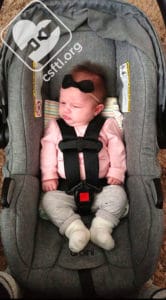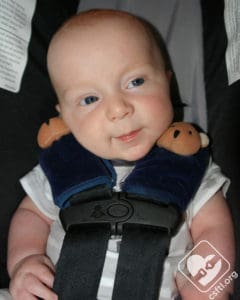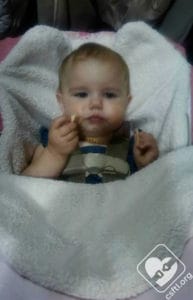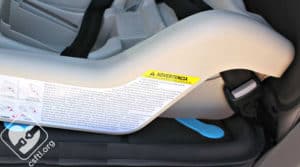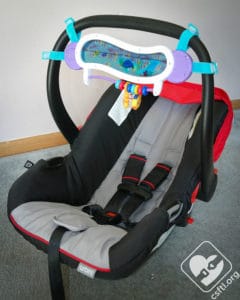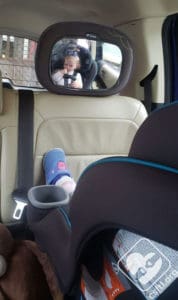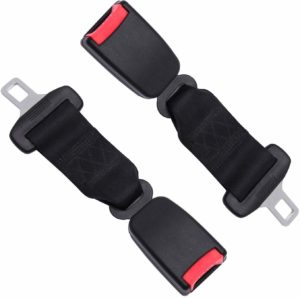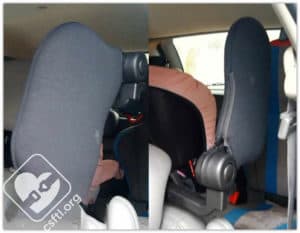Here we see a little cutie in the car seat, with some sporty-looking aftermarket products attached to the car seat’s harness. The kiddo looks comfy, but this setup isn’t the safest option. Best practice is to use only the accessories that shipped with your child’s car seat or booster seat — don’t add anything that wasn’t part of the original packaging.
As a general rule, products sold separately from your child restraint should not be used because these products may affect the safety of your restraint in a crash. Even a seemingly minor change to your restraint could alter the way the car seat or booster seat is designed and tested to perform in a crash and could result in serious injury or death.
Many products have a label that says “Crash Tested!” and may even add “to FMVSS standards” on the box or in the product manual, but this is misleading since there is nothing in the federal safety standards for car seats that covers these items. That’s why we call these products non-regulated or aftermarket.
There is no way to know how a mirror, harness pads, seat protector, or anything else that doesn’t come with the seat will change how it performs during a crash. There’s no crash test performance standard or benchmark for testing, so while companies do claim to test items like harness pads or inserts, we just don’t know which seats are being tested with which items, or how, and what the results of the tests were. We do know that any item that comes with your restraint or is approved for use by the manufacturer with your restraint has been tested with it, and is safe to use when used properly. There are, of course, gray areas. We want to give you the information you need to make an informed decision. Below we have listed some of the most common aftermarket products, concerns they may raise, and our recommendations for safe alternatives when applicable.
Infant Support Inserts, Head Rests, Pillows, and other Comfort Items
Safety Concern: Many of the items in this category will affect harness placement, pushing the child out of safe position, and may change the distance and speed the head and chest travel in a crash, resulting in serious injury or death. They also have the potential to push a newborn or young infants head forward which can compromise the child’s airway. Only items sold with your child’s car seat, or with the express written permission of the manufacturer, should be used with your restraint. The car seat’s manual will contain language to this effect.
Our Suggestion: In cases where no approved option is available, using tightly rolled receiving blankets alongside (not over the top) of your infant, clear of the harness, can be a safe method to give additional support when needed (and when the manufacturer approves). Here we see our model, with rolled blankets on either side of her head to provide additional support.
Shoulder Pads/Harness Covers
Safety Concern: Aftermarket shoulder strap pads or covers add bulk to the harness, often interfering with tightening the harness and proper chest clip placement. They may change the distance and speed the head and chest travel in a crash, resulting in serious injury or death. This product may seem harmless, but… these products are not crash tested with every car seat so there’s no real way to predict how they would perform in a crash.
Car seat manuals will typically contain language that prohibits the use of aftermarket harness covers and padding.
Our Suggestion: If your child experiences discomfort, pulling the shirt up between the harness and the child’s neck can ease discomfort. Don’t overtighten the harness straps and confirm that the harness height is at an appropriate setting for your child.
The manual will indicate when or if the harness pads on your child’s car seat restraint can be removed. Occasionally, manufacturers will have approved strap covers available for purchase — check with the manufacturer to see if these are available.
Weather Protection, Swaddlers, Bags and Caps
Safety Concern: Some of these products come between the back of the restraint and the child, which interferes with proper harness fit and introduces slack into the harness. Similar to head supports and shoulder pads, adding layers (besides street clothing) between your child and the restraint may change the distance and speed the head and chest travel in a crash, resulting in serious injury or death. Products that include a layer between the restraint and the child should not be used. Your manual will contain language to this effect.
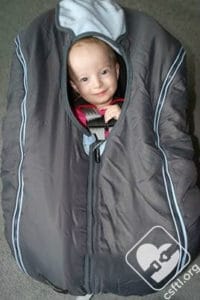
Shower cap style car seat covers don’t interfere with the harness and are generally a safe alternative
Our Suggestion: Products such as the “shower cap” style of cover or a cover that hangs from the handle may be an option if you have concerns about keeping your child warm, but proceed with caution. Always ensure the cover does not affect the installation and proper fit of your restraint, and understand that any item added to your vehicle or restraint may have an effect on safety. The best option is to dress your child in appropriate, well fitted, warm, compressed layers, (such a single layer of fitted polar fleece) and covering him or her with a favorite blanket over the properly fitted harness. Check out our helpful blog post “Hello Winter, Good-bye Coats!”
Seat Protectors
Safety Concern: A seat protector comes between your vehicle seat and your child restraint. Some have a “grippy” texture or are very firm. These can disguise a loose install, or introduce slack into the belt if the protector shifts during a crash. It is best to never use anything between the vehicle seat and the child restraint. This is a firm seat protector mat that has a “grippy” surface, making it difficult or near impossible to install a restraint over it.
Our Suggestion: Damage to a vehicle seat from a properly used child restraint is rare. Dents in upholstery or leather pop out over time. If you are concerned about mess, a thin receiving blanket can keep your vehicle seat free of crumbs and spills. An old nursing cover or similar fabric, hung from the head restraint, but not coming between the child restraint and the vehicle seat back, can protect your vehicle seat back from muddy rear facing shoes.
Other options include limiting food and beverage in the vehicle and remove shoes as well. Some manufacturers allow the use of their brand of seat protector to be used with their restraints, though a thin towel or receiving blanket can also be used. As always, confirm that the manufacturer permits the use of this type of blanket.
Make sure that the blanket does not interfere with a secure installation before deciding to use it underneath the car seat. To check, first install the car seat with the pad in place, making sure there is less than one inch of movement at the belt path. If you’re installing the car seat using LATCH, install the seat, then undo one the lower anchor connectors, remove the seat protector then reconnect the lower anchor webbing and check for movement. If using the vehicle belt to install the car seat, mark the latchplate position with chalk or use a locking clip to hold the vehicle seat belt, remove the seat protector, and buckle the belt. If either of these tests lead to a loose install, discontinue use of the seat protector and try one of the options listed above. Check out our full article on seat protectors and car seats.
Custom Covers
Safety Concern: Covers that were not made by the manufacturer and tested with your seat may interfere with harness fit and flammability. It may also change the distance and speed the head and chest travel in a crash, resulting in serious injury or death. Only covers provided by the manufacturer for your model of restraint should be used.
Our Suggestion: If your cover needs to be replaced due to wear, or damage, contact the manufacturer to purchase a replacement cover. Occasionally covers for restraints can be found second-hand; this may be an option for you as well. Look for the brand, and other required labeling, to ensure you are getting an approved option.
Mirrors / Toys
Safety Concern: Anything in your vehicle can become a potential hazard during a crash. A mirror could break, or cause additional injury if it came loose from the headrest and became a projectile. Toys hanging from a seat (particularly the handle of a rear facing only seat) can hurt the child if they go flying into their face, or can pose a strangulation hazard if the attachment is long and flexible.
Our Suggestion: If you find it necessary to see your little one via a headrest-mounted mirror, perhaps due to a health issue, be aware of the risks involved before making your decision. Only choose a mirror made of soft, flexible materials that can be tethered to minimize these risks. Remember that a mirror can be a distraction hazard, so keep your eyes on the road and only check on your Little if you’re not the driver or if you’re at a complete stop in an appropriate and safe spot to do so. The same rule applies to toys – stick with items that are soft and lightweight.
Waterproof Pads
Safety Concern: Products marketed to keep your seat safe from accidents and spills may interfere with proper harness fit.
Our Suggestion: It is best not to have anything between your child and his or her restraint, however we understand this is not always practical, especially when potty learning. While some manufacturers do offer an approved waterproof insert for ‘accidents’, for other seats look into placing a diaper cover or pair of rubber pants over a child’s under pants until you’re reasonably confident that he/she is ready to face the world diaperless.
Seat Belt Extenders
These products are designed for larger adults who need a little extra webbing in the vehicle seat belt. Seat belt extenders are often vehicle-specific and sold by a variety of vendors. This type of product is NOT designed for use with car seats or booster seats.
With an increase in vehicles that have recessed buckle stalks, we’re seeing caregivers choose this type of non-regulated product to provide booster riders with easier access to the buckle. Unfortunately, this is a very unsafe scenario. We would strongly recommend that families in this situation select a differently-shaped booster seat instead of adding this type of product to their child’s seat belt.
Seat Belt Adjusters
These products claim to move the adult seat belt into a more comfortable or more appropriate position for the child. They may do that in a pre-crash scenario, but we have no way of knowing how they’d perform in a crash.
If a child “needs” a product like this in order to have the vehicle seat belt fit them properly, it’s unlikely that they would pass the Five Step Test so they’d still be safest to ride in a booster seat.
Headrests for Booster Riders
Safety Concern: The Cardiff Booster Seat Headrest / Travel Headrest can potentially interfere with active head restraints and/or side impact air curtains in the event of a crash. This means users could sustain head or neck injuries in a crash. When installed on a vehicle head restraint, the Cardiff Booster Seat Headrest forces the vehicle headrest to be higher than the lowest position. For smaller riders, this could mean less than ideal placement of a head restraint. Additionally, smaller riders leaning to the side to use the Cardiff Headrest may end up out of position for adequate seat belt protection.
Our Suggestion: If your child cannot sit upright during car rides, consider putting them back in a harnessed car seat or in a high back booster if they fit within the height and weight requirements, particularly on long car rides when they may fall asleep. You can teach your child to look at the ceiling if they are feeling sleepy. Put a sticker on the ceiling of the car to remind them to look up. Try not to travel at times your child is likely to fall asleep.
Footrests for Forward Facing and Booster Riders
Safety Concern: aftermarket footrests that slide under a car seat or booster seat could interfere with the seat’s ability to properly protect children in the event of a crash — they could loosen a secure install or become a projectile in the event of a crash.
Our Suggestion: a small styrofoam cooler or foam block that sits on the vehicle floor under the child’s legs can provide additional support for dangling legs.
What Manufacturers Say
Your car seat or booster seat’s manual will usually include very specific warnings or instructions about what you can use with your child’s restraint. We’ve chosen several different restraints from different manufacturers and taken excerpts out of their manuals so you can see what their warnings include and where you might find it in the manual. Some of the seats mentioned in this list are discontinued but we wanted to continue to show how to find this information for your child’s car seat.
Information found in various car seat manuals around aftermarket products:
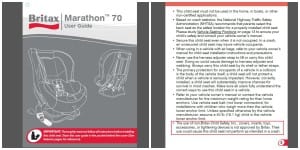
Britax Marathon manual on non-regulated products
Britax Marathon 70
The use of non-Britax Child Safety, Inc., covers, inserts, toys, accessories, or tightening devices is not approved by Britax. Their use could cause this child seat to not perform as intended in a crash.
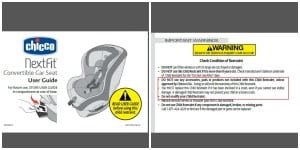
Chicco NextFit manual on non-regulated products
Chicco NextFit:
DO NOT use any accessories, pads, or products not included with this Child Restraint, unless approved by Chicco USA. Doing so will void the warranty of this Child Restraint.
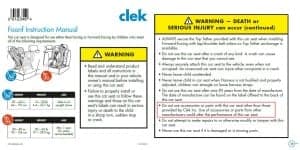
Clek Foonf manual on non-regulated products
Clek Foonf:
Do not use accessories or parts with this car seat other than those provided by Clek Inc. Use of accessories or parts from other manufacturers could alter the performance of this car seat.

Combi Coccoro manual on non-regulated products
Combi Coccoro:
DO NOT use accessories or parts other than those provided by Combi USA, Inc. Use of accessories or parts from other manufacturers could alter the performance of the car seat.
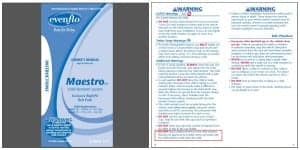
Evenflo Maestro manual on non-regulated products
Evenflo Maestro:
DO NOT attach additional items to this child restraint that are not approved by Evenflo. Items not tested with the child restraint could injure the child.

Graco SnugRide manual on non-regulated products
Graco Snugride 30:
DO NOT MODIFY YOUR INFANT RESTRAINT AND BASE or use any accessories or parts supplied by other manufacturers.

Graco Nautilus manual on non-regulated products
Graco Nautilus:
DO NOT MODIFY YOUR CHILD RESTRAINT or use any accessories or parts supplied by other manufacturers.
Each restraint’s manual may be different, and there also may be some differences between different versions of manuals for the same restraint because manuals are sometimes updated over time. This article is not intended to replace reading your restraint manual. When in doubt, refer to your manual or contact the manufacturer.




